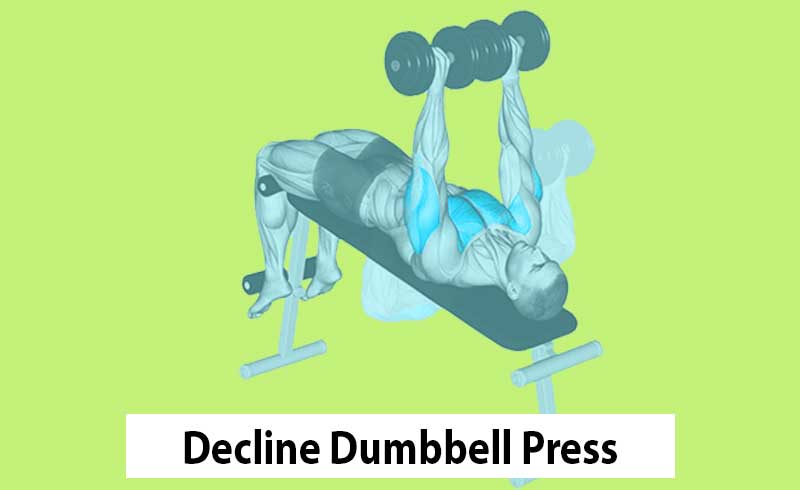The decline dumbbell bench press is a powerful variation of the traditional decline bench press exercise that incorporates dumbbells.
This workout offers a broader range of motion, engages more stabilizing muscles, and targets the lower pectoral muscles.
In this guide, we’ll go through how to do this exercise correctly, explain the muscles worked, and provide you with important tips for a secure and effective workout.
Decline Dumbbell Press Muscles Worked:
The decline dumbbell press is a powerhouse exercise that engages several key muscle groups to orchestrate a harmonious movement. Let’s explore the intricate workings of these muscle groups:
Chest (Pectorals):
The primary muscle group that takes center stage during a dumbbell decline bench press is the chest, scientifically known as the pectoralis major (pectorals).
These muscles extend across the front of the upper torso and insert into the humerus, the large upper arm bone.
The pectorals are responsible for arm adduction (bringing the arms together) and arm extension (moving the arms away from the body).
The beauty of decline pressing lies in its ability to emphasize distinct regions of the pectorals due to the orientation of muscle fibers.
Exercises that induce arm movements in the opposite direction—horizontally and downward, effectively stimulate this lower region.
Front Deltoid Head:
The front deltoid head, a component of the shoulder muscles, plays a crucial supporting role during the dumbbell decline press.
As we extend our arms during the pressing motion, the front deltoids lend their strength to assist the chest muscles.
This collaborative effort ensures seamless arm extension and contributes to the overall stability of the movement.
Middle Deltoid Head and Shoulder Stability:
While the front deltoid head is a prominent player, the middle deltoid head also joins the performance to maintain the stability of the shoulder joint.
This stabilization role adds an extra layer of precision to the exercise, ensuring a controlled and effective movement pattern.
Triceps:
The triceps, the three-headed muscle at the back of the upper arm, eagerly jump into action during the dumbbell decline press.
As the dumbbells are pressed upwards, the triceps become instrumental in the arm extension process.
With each repetition, the triceps take on more responsibility as we approach the top position, contributing significantly to the completion of the movement (1).
Core Muscles:
The decline bench press does not solely work your chest, it engages the core muscles in a supportive capacity.
The rectus abdominis, transverse abdominis, internal and external obliques, and even the glutes collectively form the core group.
These muscles execute an isometric contraction, stabilizing the body and bench during the pressing motion.
By maintaining stability, the core muscles enable a safe and effective performance, ensuring that the movement is controlled and efficient.
Dumbbell Decline Bench Press Benefits:
- Enhanced Muscle Recruitment: Balancing dumbbells during the exercise engages more stabilizing muscles, leading to increased muscle fiber recruitment.
- Unilateral Training: Performing the decline press with dumbbells allows unilateral training, improving core stability and addressing muscular imbalances.
- Joint Safety and Natural Movement: Dumbbell decline chest press provides greater joint safety, enabling natural movement within the range of motion.
- Increased Muscle Fiber Engagement: The extended range of movement in dumbbell exercises recruits more muscle fibers, contributing to comprehensive muscle development.
- Variety and Preventing Burnout: The versatility of decline dumbbell press variations prevents physical and mental burnout, promoting consistent progress.
- Improved Muscular Control: Dumbbells require enhanced muscular control compared to barbells, leading to improved kinesthetic awareness.
- Lower Chest Targeting: The exercise effectively targets the lower chest, sculpting a well-defined and muscular upper body.
Decline Dumbbell Chest Press Angle:
The decline bench press’s effectiveness depends on getting the bench angle right.
Research suggests that an optimal angle of 15-30 degrees declined from flat targets the lower chest muscles most effectively while minimizing stress on the anterior deltoids.
How to Perform the Dumbbell Decline Bench Press Properly?
Follow these step-by-step instructions to perform the declined dumbbell bench press correctly:
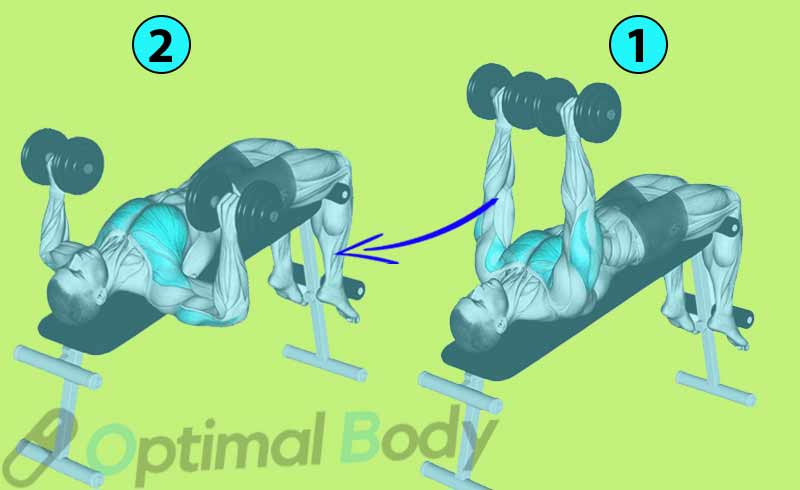
- Begin by grasping a pair of dumbbells with a neutral grip (palms facing inward). Situate the dumbbells at the hips’ crease, then position yourself on the decline bench.
- As you lie down, hold the dumbbells close to your chest. Take a deep breath and press the dumbbells upward until you reach the top position.
- Lower the dumbbells slowly while maintaining control over the movement. Aim to lower them as far as comfortably possible, ensuring the handles are approximately level with your chest.
- Contract your pectoral muscles and push the dumbbells back to the starting position.
- Repeat the movement for the desired number of repetitions.
Training Volume for Decline DB Press:
A recommended starting point for training volume is 3-4 sets of 8-12 reps. Choose a weight that allows you to execute the exercise with proper form and induces muscle fatigue within the rep range.
Exercise Tips:
To maximize the benefits of the declined dumbbell bench press, consider these important tips:
- Maintain Tension: Avoid fully locking out your elbows to keep tension on your chest muscles throughout the exercise.
- Control the Dumbbells: Prevent the dumbbells from colliding at the top of each repetition, as this could compromise shoulder stability and lead to injury.
- Keep Shoulders Secure: Squeeze your shoulder blades together to ensure that your shoulders remain stable and protected. This prevents them from rolling forward during the lift.
- Protect Your Shoulder Joint: If you experience discomfort in the front of your shoulder joint, retract your shoulder blades slightly and maintain proper scapular positioning.
- Engage Your Core: Keep your abdominal muscles engaged to support your lower back and prevent excessive arching.
- Steady Lower Body: Plant your feet firmly on the ground and avoid any unnecessary movement in your lower body during the exercise.
Proper Form and Mistakes To Avoid:
- Controlled Motion: Avoid jerky movements and maintain controlled motion.
- Appropriate Weight: Use weights you can handle comfortably.
- Correct Bench Angle: Set the bench at 15-30 degrees decline.
- Tension Management: Keep tension on the lower chest during the lift.
- Straight Line Press: Press the dumbbells in a straight line for efficiency.
- Range of Motion: Utilize the full range of motion and control the dumbbells.
- Shoulder Stability: Pinch shoulder blades together for stable shoulders.
- Avoid Colliding Weights: Prevent dumbbells from colliding at the top to maintain stability.
Decline DB Press Variations:
1. Dumbbell One-Arm Decline Chest Press:
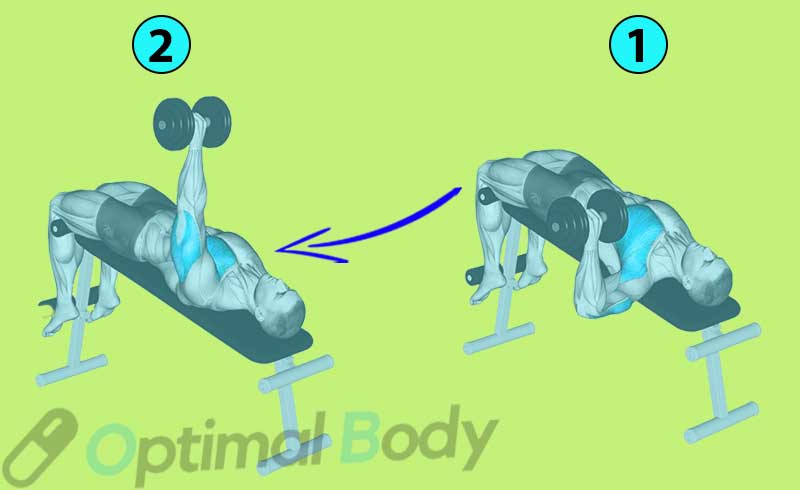
Targeting the lower pectorals using one arm at a time, this variation enhances balance and addresses muscle imbalances. This exercise is particularly effective for building unilateral strength.
2. Decline Hammer-Grip Dumbbell Bench Press:
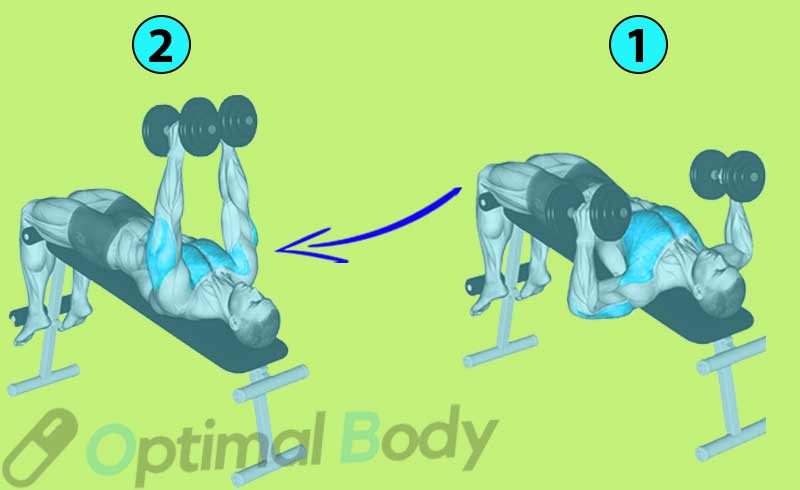
This variation involves a neutral grip, engaging the lower pectorals, triceps, and shoulders. The neutral grip protects the shoulder joints, making it a safer alternative.
3. Dumbbell Decline One Arm Hammer Press:
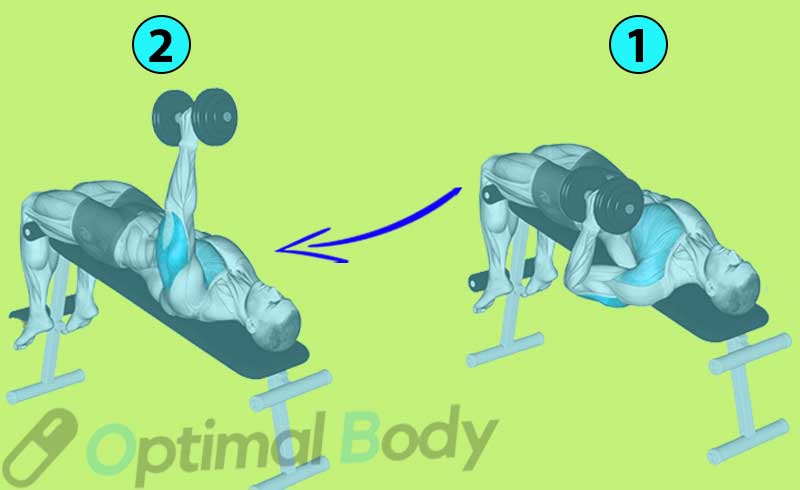
Best Alternatives To The Decline Dumbbell Chest Presses
1. Chest Dip:
The chest dip is a bodyweight exercise that targets the lower pecs, making it a suitable alternative to the decline dumbbell press. It’s particularly beneficial for those who prefer bodyweight exercises.
2. High Cable Chest Fly:
If you have access to cable equipment, the high cable fly is an excellent alternative. It isolates the chest muscles and provides constant tension throughout the movement.
4. Decline Cable Bench Press
5. Decline Barbell Press:
Similar to the decline dumbbell press, the decline press targets the lower pectorals by adjusting the bench angle. It’s an effective alternative to the dumbbell version.
6. Decline Dumbbell Fly:
This variation involves a fly motion on a declined bench. It enhances the stretch and contraction of the lower pecs.
Conclusion:
The decline dumbbell bench press is a versatile exercise that offers a unique way to target the lower pectoral muscles while engaging multiple muscle groups.c
By following the proper technique and incorporating the provided tips, you can perform this exercise safely and effectively, leading to improved chest strength and development.
- Bench Press Calculator - April 22, 2024
- Press to Handstand: Ultimate Step-by-Step Guide - April 22, 2024
- Cable Press (How To Do, Benefits, Targeted Muscles, Alternative) - April 22, 2024

